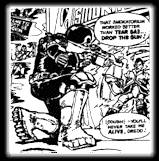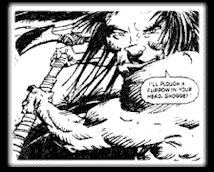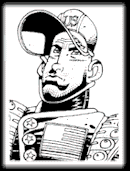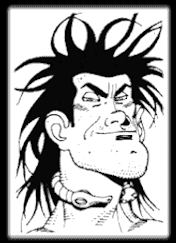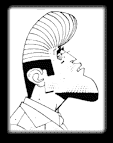|
McMahon Interview Mike McMahon's work has provided some of the definitive versions of some of Britain's favourite characters, Judge Dredd, Slaine, ABC Warriors and now Sonic. His art has set a standard of storytelling and innovation unparralled. Few artists have so boldly defined and redefinded their style, in a market saturated with pin-up artists, Mike's work provides inspiration and excitement and a motivation to find out where he'll go next. Mike is an artist at the forefront of his craft and his style will continue to evolve and influence. The Academy dispatched Rookie Rufus Dayglo to interview the Droid himself... |
|||||||||||
| RUFUS:
How did you get into working for 2OOOAD you were straight out of art
school weren't you?
McMAHON: That's right, I'd been out of art school a year and I'd got into an agency, I'd seen a copy of 'Eerie' which had just started being published in this country by Warren Magazines... and Paul Neary was working on it, and I was really impressed with his stuff I did this story about knights and dragons in kind of a Paul Neary style, it was really "blocky". They were only pencilled but my agent took it to Fleetway and the next thing, I got this script for Judge Dredd, and that was that.
R: Your style's changed from starting off with the Ezquerra influence towards a stronger style and then Slaine the very cross hatched woodcut style. Were you aiming to do that specifically for the Slaine story, or were you just trying out a new technique? McM: No, the changes in style came about because of what I'm trying to do with the story really. When I start something new I can spend a month not producing anything, trying to internalise it all, and then when I've done that it comes out how I feel it should be, it's an instinctive thing really, but I wouldn't say it suits "this" particularly it's just what feels right. R: Yes, like "The Block Wars" has a very solid black whereas before your black were sketchy, the solid black really brings out the harshness. McM: Yes, because on Dredd, I'd done him for such a long time, the style evolved... It was a separate thing I would've got bored doing it one way, and tried to make it better, well, what I thought was better anyway, and I'd change it but it wasn't a calculated change, it just evolved really. I'd see something I'd done earlier and think, yes, that's all right and make everything lean in that direction, maybe see even a small head in the background with a shadow on it a certain way.R: I think people are surprised by your work changing story to story, just when we think we know where you're coming from, (like with Slaine and Block wars) and then your move to the "Last American" a lot more linear and hard edged and all the line with a similar weight. McM: Yes, it's to do with materials as well, what's available, I'd started using staedtler projector pens on Bristol Board, they worked really nicely filling in solid blacks on Bristol Board, and then when I was doing Slaine I switched to water-colour paper, I don't know why, and so I started drawing everything with these pens, but it didn't work at all, it was too blobby, but I liked the things I was doing with these pens, but they were to uncontrollable, so I started using Tombo pens. R: On the "Sky Chariots" you worked on tracing paper.
R: Were you keen to do the covers for the reprints as the 2OOOAD artists didn't get royalties? McM: Well, yes, because they paid quite well for the covers which was some sort of compensation I suppose. But back to the Slaine style. It was a combination of these accidents with pens and papers and my nerves. But then I see what I'm doing and understand what I'm doing and then evolve it into something much stronger, I think later on it gets much more competent, say, where we get to the actual episodes where ships are flying around I think they were quite strong because I was in control, I had confidence, I was actually inking & penciling on the paper then. It gets more confident and that's what it's about. So when I come to the end of something like Slaine because the style's evolved,although it has similarities, it has evolved as I went but there was a
McM: No, I just got faster and as you go along you understand what you're doing a bit more. I didn't do as much redrawing on that as other things I've done, It was the first story I'd stuck panels on. The first one was his wife and family in the snapshot the first time I drew that it was awful, so I redrew it and stuck it on. It was hard work on Last American' coming up with new ways of him looking out the window! It was really exhausting. I thought it was going to be an action book, but it wasn't. R: Did you see yourself as an action artist? McM: I did, but I'd take the same approach to anything Dredd or Sonic, it's all grist to my mill, I find I'm more confident in my ability to do different sorts of subject matter. To do something like Sonic well it's so rigorous, because all it is, is storytelling you've got to have a lot of experience, you can't show off... Well you can, but you have to be clever. R: A lot of modem comics have tended more towards the pin-up, a more art style mag as opposed to telling a story. McM: The problem a lot of artists have is the scripts are not really narratives anymore they seem to be more polemics really. I mean, if an artist is given a script with a story they wouldn't be allowed to go week after week doing pin-ups. You look at a lot of these things and there a story to draw, it's just people (characters) being cool. I have to say I don't look at many comics now. since I was 7 or 8 and my first job had nothing to do with the war and I didn't care, Hooray I've got a job (laugh). If you want to be a professional artist you have to be flexible, well I mean now a days there is no work around, you have to take what you can get. All I think about is what I don't want to do. If you pin yourself down to what you do want you exclude so much. There were things I've done in the past I enjoyed a lot, like the 'Alien Legion' book, I
McM: I break down whole stories usually. My favourite way of working is to pencil a panel and then ink it, but often they insist on seeing pencils, although my pencils are inked if I've got to think up panel alter panel I get bogged down, if I'm inking one I can think up the next one. R: With Sonic, do you have to send the pencils off to be approved? McM: Yes by Sonico (Games company), they phone me up to go ahead or redraw his foot or something, I don't mind, if you do licensed characters that's what they are about. R: What comics did you read when you were growing up? McM: British ones and some American. I never found out a lot of the artists names because they were from South America or wherever. I liked Russ Heath, I never really liked Kirby, I can appreciate him now, and because I know what he did, but when I used to see his earlier work and imagine it in black and white, (because that's what I'd grown up reading,) and I used to think, well there's not much there, is there? I think it's because his style was so sophisticated then, when I was 6 or 7 it went right over my head, but I look at it now and appreciate it, but he never influenced me. I suppose my main influence was stuff in magazines like "Look & Learn" lots of illustrations like the battle of Agincourt and Romans and that sort of stuff R: Did you read European comics, Heavy Metal, Moebius?
McM: No. There's no satisfaction, I like doing a story, I suppose that's why I've stopped doing those flashy layouts and big pictures and stuff, it's subverting the story. When I look back on the old Dredd stuff the clarity's appalling, you can't see anything. I suppose what I regard myself really as is someone who can string a sequence of pictures together you can follow quite easily. Which is why I'm quite comfortable doing something like Sonic, because I've got that facility now. I suppose I could still do smart alecky things, but I only used to do that to cover up what I considered to be my inadequacies, because I knew if I did a regular 6 panel page my hopeless drawing would stick out like a sore thumb, so I disguised it. That's why you see letratone, oh that bits boring! better stick some tone on it, but I'm confident enough now not to need to show off like that. R: Like the later Dredd, "The Howler" is just so simplified. McM: In a way the work I'm doing at the moment is more... decorative than the Howler because I started to peel everything down in the Howler to build it back up again. Because I felt I'd lost my way with lights and shade, but I've got it back now but it's back in a different way. The things I drew for the "Paradox Big Book" is more at the style I'm at, but Tattered banners' won't look like that because I started it straight after the howler and I can't change horses midstream, but anything else I do will be much more elaborate, I think. I suppose the stuff I've done recently like "Decapattack" (Sonic) I really like because I drew it with a calligraphy pen (Pilot Calligraphy #1 & #2) and that was great because they looked quite lull, even though there wasn't a lot of line work on them, which is something I wouldn't have done before because I've always used single thickness nibs, those pages move, more thoughtful. It's like Carl Barks, his stuff was so sophisticated it's so totally devoid of any ego and that's what I'm trying to do in Sonic, not draw like Carl Barks, but to throw out any element of self, the bare bones. R: The McMahon Zen approach? McM: (Laugh) Yes it's true... I'm not trying to impress anyone I'm just trying to tell the story. R: Well, your work in 2OOOAD influenced people in my generation and Sonic will influence new kids... McM: Maybe. It's a well-made comic, but I think kids are more impressed by flashy stuff; I know I was, the people who can do a good effects. When I was there, there were things you wanted to like, but like a girls comic I wouldn't have liked, but now I'll appreciate the work because I know what goes into it, like I was saying about Kirby... Subject matter that's what I think it is, that's why my work was popular when I was starting out because it was a popular character, but if I'd been drawing Harlem Heroes... R: But it was your artwork that made me pick up 2000AD and Battle because of your covers, I didn't know the characters but I loved the style. The first comic I bought with my own money was the Battle with your cover. McM: Oh, I never really think of it like that really. I suppose there's that cult of personality around say, Jim Lee or whoever, people who like their work per se but then if you were doing a specific character you're work would be popular. R: Well people I've talked to know specifically which stories you've done and when you did them. McM: Well, Oh, I never thought of it really I used to think of like Ramon Sola who did 'Flesh', it was fantastic when he was doing it, and I would've thought that because he is such a good artist that he would've been more popular than I was, but I was drawing Dredd, you don't agree. R: No, you brought such a lot to the stories I used to be pissed when I picked up a comic and you're work wasn't in it, especially if you were doing the cover. There was always that moment, is it McMahon? AAH no, it isn't skip that then. McM: (Laugh) It always struck me it was the character, but like when Slaine came along, I immediately put my name in for that. I just thought whoever was drawing Dredd would be the most popular... No? R: No, No, The stories were strong but it was your art really it wasn't the same without it. I mean there was incredible artists, but... McM: A lot of artists were overlooked. I always thought it was the character. R: No,
for me it was your characterisation really, your style.
At this point the tape on the Dictaphone ran out, but I would just like to
take this opportunity to thank the McMahon's for the hospitality towards
Rufus during his time at their home, interviewing Mike, and pass on my
thanks for the original artwork Mike did to accompany this interview. |
|||||||||||
